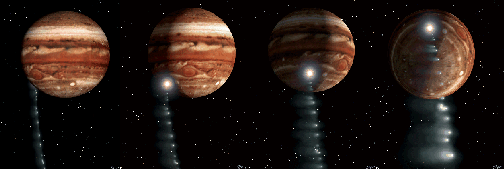
Jupiter has a mass of 1.90 * 10^27 kg. It is more than twice as massive as all the other planets combined. It's radius is 71,492 km - that's 11 times the radius of Earth! Gravity on Jupiter, like anywhere else, is determined by Newton's law of Universal Gravity: F = G m1m2 / R^2. Gravity on Earth is 9.81 m/s^2, whereas the surface gravity on Jupiter is 22.88 m/s^2.
Jupiter is the largest planet in the solar system. The fifth planet from the sun, it is a gas giant with 39 moons. That's more moons than any other planet in the solar system! The four largest are Io, Ganymede, Callisto, and Europa. They were discovered by Galileo Galilei in the early 1600's. As a gas planet, Jupiter doesn't have a solid surface. It is made up of 90% hydrogen and 10% helium. It's density increases the further you go (if you could go there!) into the planet. It is believed to have a rocky core, whose mass is roughly equal to 10-15 times the mass of Earth.
image courtesy of http://www.uwrf.edu/sps/ccd/jup-moons-9-28.gif
One period of rotation (what we here on Earth call a day) for Jupiter is 9 hours, 55 minutes. It takes the equivalent of 11.87 Earth years for Jupiter to revolve around the Sun.
image courtesy of: http://seds.lpl.arizona.edu/nineplanets/nineplanets/jupiter.html
Jupiter has a very faint ring system believed to be made up of dust particles from it's moons. These particles are knocked from the moons by meteor impacts.
In 1994, Jupiter was struck by the comet Shoemaker-Levy 9. This was the first chance scientist had to witness the collision of two extraterrestrial bodies. This collision caused quite a stir in the scientific community, and it's after-effects were visible for nearly a year.

image courtesy of http://www.jpl.nasa.gov/sl9/sl9.html